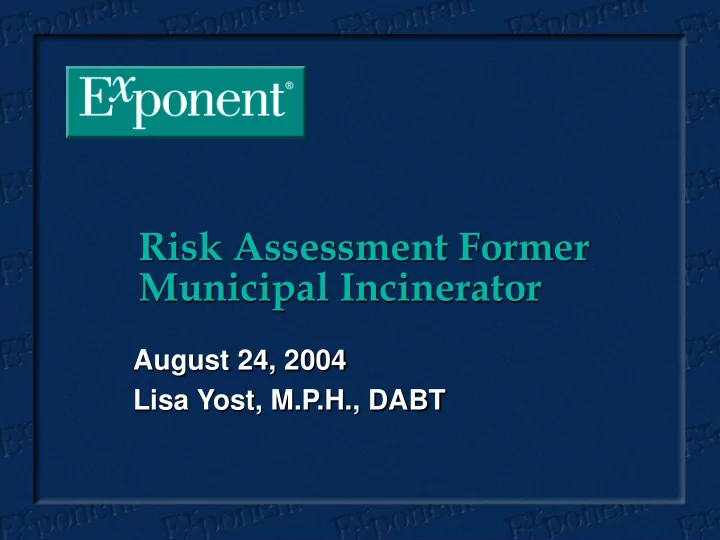

Risk Assessment Former Municipal Incinerator August 24, 2004 Lisa Yost, M.P.H., DABT
Risk Assessment Framework Exposure Assessment • Scenarios • Pathways • Intake rates Risk Characterization • Carcinogenic Cleanup Evaluate Chemicals of Levels • Noncarcinogenic Concern Results • Uncertainties Toxicity Assessment • Validity of data • Relevance Implement Controls
Context of Risk Assessments • Waste-to-energy facility operated 1985 to 2000 cooperatively with SJC • Prior operations resulted in residual contaminants – EPA conducted a Site Inspection in 1994 – State required further investigation beginning 2001 – Concerns regarding offsite migration • Human health and ecological evaluations • Consideration of cultural resources
Project Team • Directed by City of Sitka • Regulatory oversight by DEC • Conducted by: – James Clare, PE, LLC — Investigation – Exponent — Risk Assessments • Reviewed by: – Sheldon Jackson College – Sitka Tribe – Public
Context of Risk Assessment in Overall Process
General Decision Framework for Screening Chemicals of Potential Concern
Contaminants of Potential Concern (CoPCs) • Metals – Chromium, cadmium, mercury • Residuals from burning – Dioxins (PCDD/Fs) – Polycyclic aromatic hydrocarbons (PAHs) • Residual petroleum
Human Health Exposure Pathways
Human Health Exposure Assumptions • Health protective assumptions applied – Worker and daycare child assumed 250 day per year exposure (25 years) – Visitor assumed 24 days per year (30 years) – Gravesite visits assumed 6 times per year (30 years) • Hypothetical residential scenario evaluated – Adult and child evaluated – Assumes long-term residence – 350 days per year for 30 years
Risk Estimates for Human Health Scenario Risk Estimate Risk Estimate Adult Child Occasional visitor 2x10 -5 3x10 -5 Hypothetical resident 3x10 -4 5x10 -4 Gravesite visitor 1x10 -6 2x10 -6 Daycare worker / child 7x10 -7 2x10 -6
Ecological Assessment • Screening based on conservative toxicity benchmarks and on exposure assumptions identified by DEC • Contaminants of concern identified – Metals (cadmium, chromium, lead, and mercury) – Dioxins (PCDD/Fs) • Indicator species evaluated in food web model – Mink, robin, Sitka mouse, shrew, and great blue heron
Ecological Exposure Pathways
Ecological Assessment—Results • Risk assessment could not rule out potential for impact based on comparison to screening values • Effects, if any, restricted within wetland area • Population-level effects highly unlikely in terrestrial area • No effects on fish
Conclusions • Human health and ecological risks are within acceptable levels for current use • Potential for elevated risks can be managed with use restrictions: – Residential use should be restricted – Subsurface excavation may require special health and safety procedures • Offsite migration limited to adjacent wetland
Recommend
More recommend